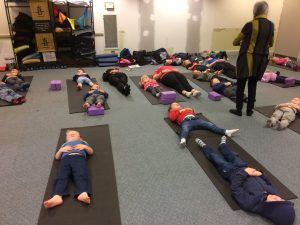Dear Yogis,
Over the last few weeks we have been focussing on all things HEALING, and today I thought we could detour to SINGING BELLS. These are often overlooked as a healing modality on their own, but now in America, thanks to the artist Guadalupe Maravilla, therapists and even scientists are taking a second look. CCP GRADUATES TAKE NOTE.
Maravilla used these therapies on himself whilst recovering from cancer. When he discovered their effectiveness he started to construct installations based on sound so that others (especially children) could experience this therapy. Not exactly new, and overcomes the complaint “I want to meditate but I can’t”. Add pain to this perceived difficulty and you have a client who will resort to heavy duty pain medications instead of moving forward into yoga based therapies. With sound therapies there is no learning curve, you just lie on the mat and let go.

Merely lying down and listening to the high-intensity, low-frequency combination of singing bowls, gongs, and bells in a sound meditation could induce a deep relaxation response and positively affect mood and sense of well-being. Sound healing has been used for centuries by yogis and utilized in various forms by cultures the world over, including native peoples. Although we don’t think of it the same way, Australian aboriginal tribes have used the didgeridoo as a sound healing instrument for over 40 000 years. Ancient instruments have also been used for religious and spiritual ceremonies such as Tibetan (also called “Himalayan”) singing bowls, originally used by Tibetan monks for spiritual ceremonies.
Heart disease, diabetes, addiction, and mental health issues have all been linked to stress and tension. Meditation, including systems such as mindfulness-based meditations, has shown promise in inducing the relaxation response and helping alleviate anxiety and improve well-being. The relaxation response is the body’s physiological response in relaxation, including lowered blood pressure to counter the fight-or-flight response and activation of the parasympathetic nervous system.
In one study, singing bowls were used for emotional healing with high-risk youth as part of what was termed the best self-visualization method. The bowls were used in a psychotherapy model in combination with deep breathing, visualization, and a loving kindness meditation. The authors of the studies I have read reported that this combination of healing methods may be a catalyst for emotional and psychological healing in counseling sessions.
The studies does, provide the groundwork for future research regarding the effects of singing bowl meditations on assessments of stress and well-being. As we have discovered in Yoga meditations, this low-tech form of meditation may have the capacity to lower blood pressure and heart rate, thus there are potential benefits to cardiovascular health yet to be further explored. The results provide promise for a form of stress reduction that does not require the individual to learn a disciplined form of meditation. In fact, the participant may even fall asleep if desired. At the very least, participants generally express feelings of deep relaxation and inner peace following the sound meditation.
Moreover, those in health professions (and as I have said, CCP Graduates), nurses and counselors could easily provide these meditations to patients. While it may require a very minimal amount of practice, extensive training is not necessary to learn to play the singing bowls and other instruments, thus, this type of meditation could be taught to health and counseling professionals and provided in an almost unlimited number of settings to induce the relaxation response, reduce stress, and potentially stress-related disease in the body.
I am sure that there are ongoing studies, and over time we will learn of the bowls remarkable properties in depth. In the meantime, let’s take the opportunity to take these therapies into various settings (and in our studios) and introduce it to clients. Not as a special occurrence, but as a regular part of our practice.
SEE YOU ON THE MAT.
NAMSATE. JANE



